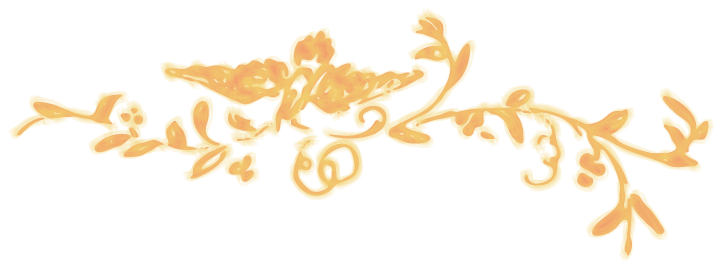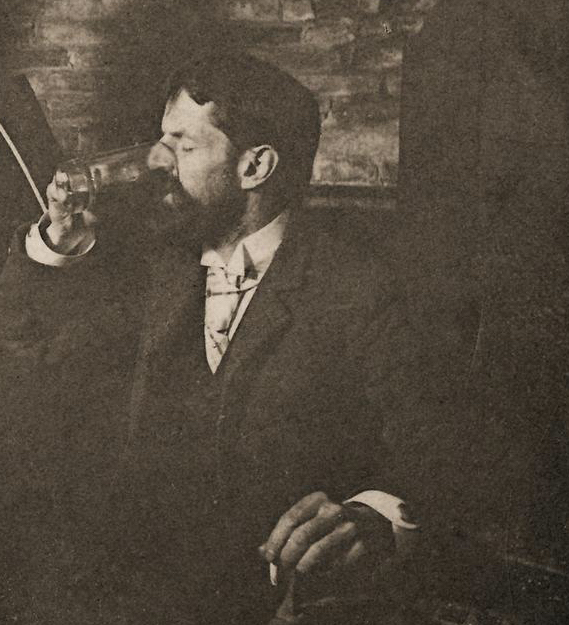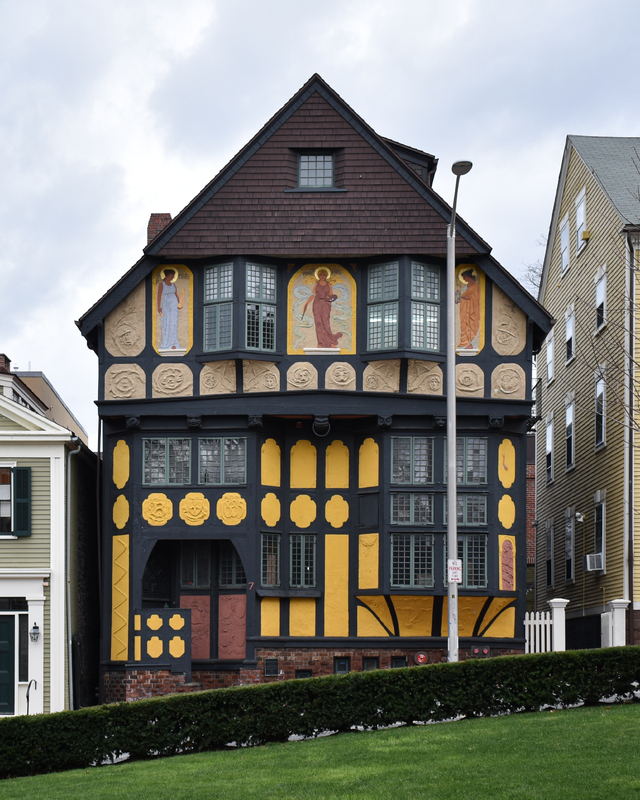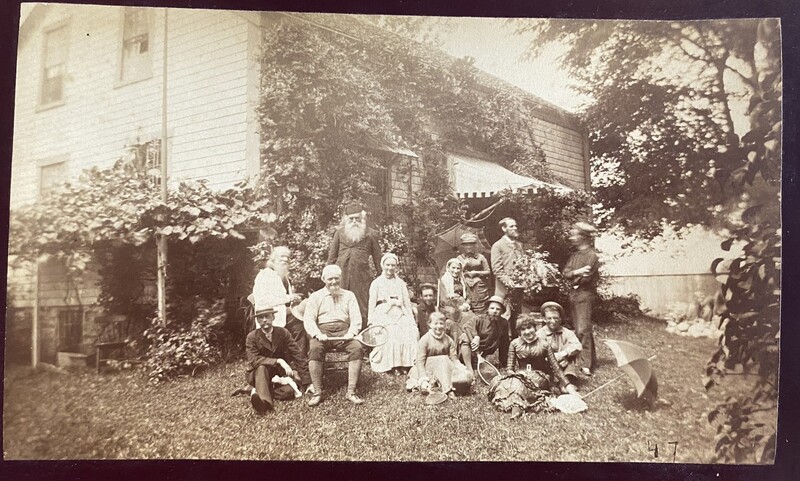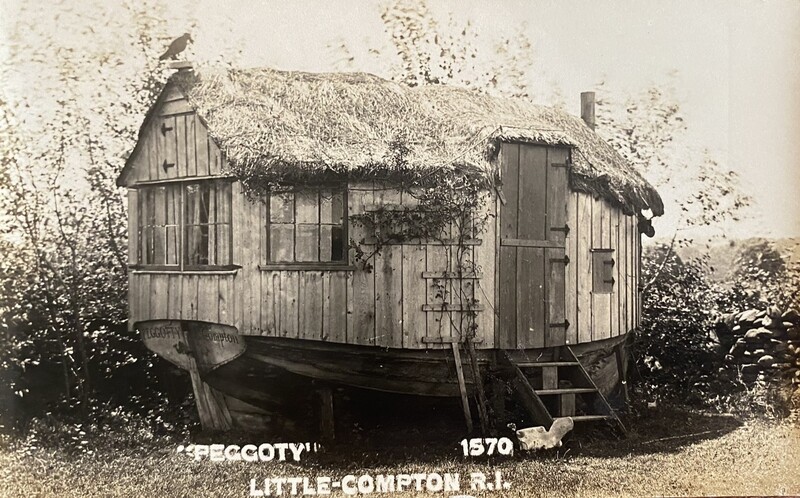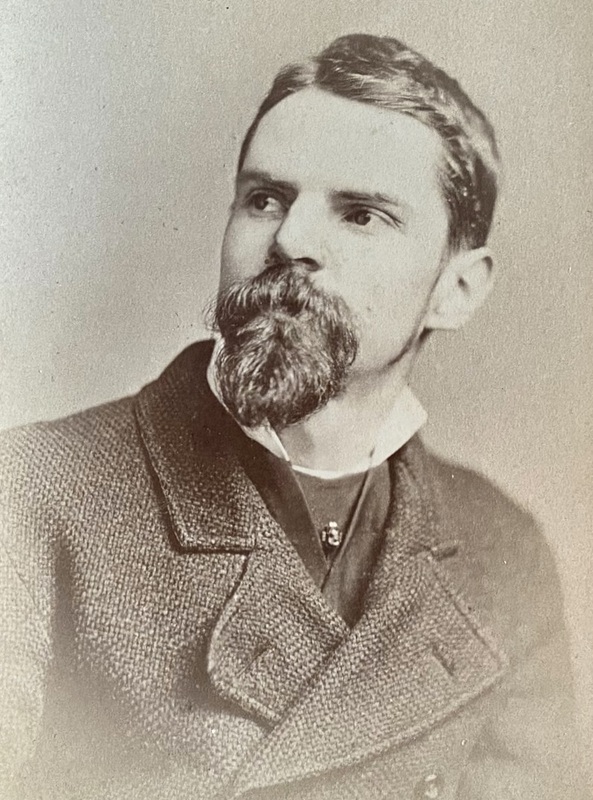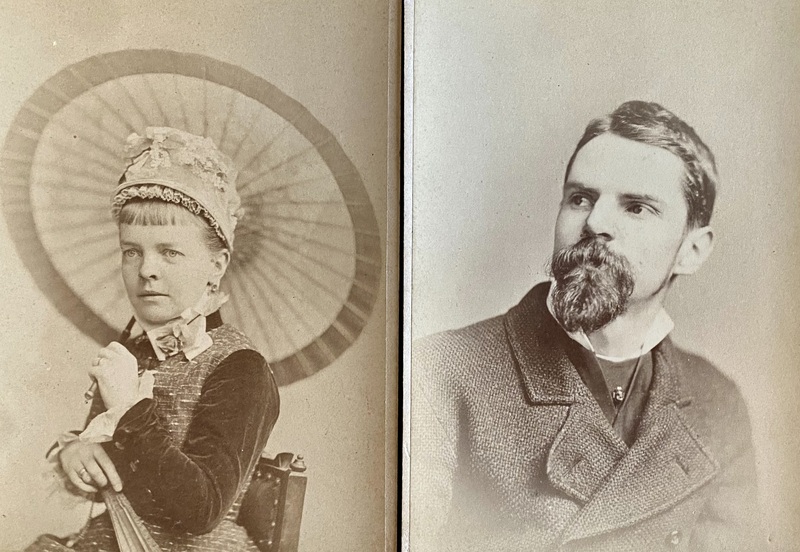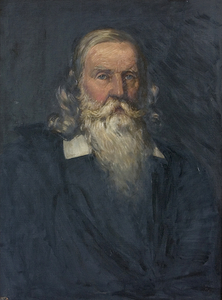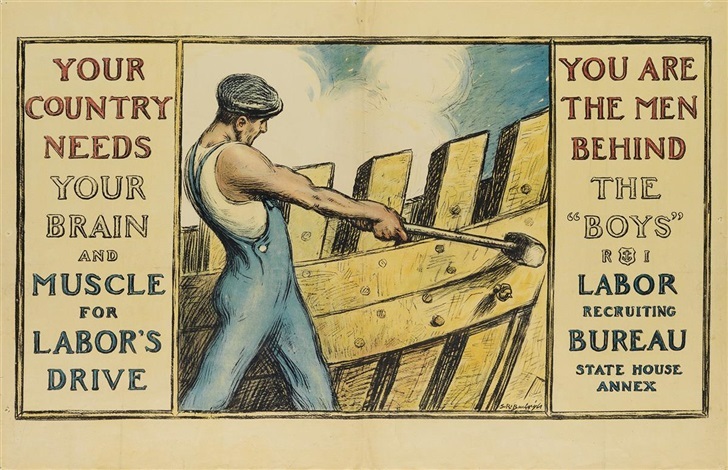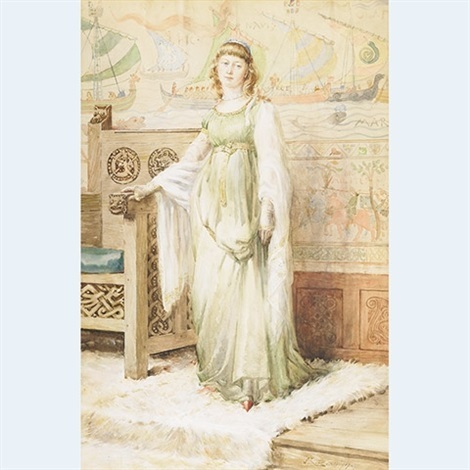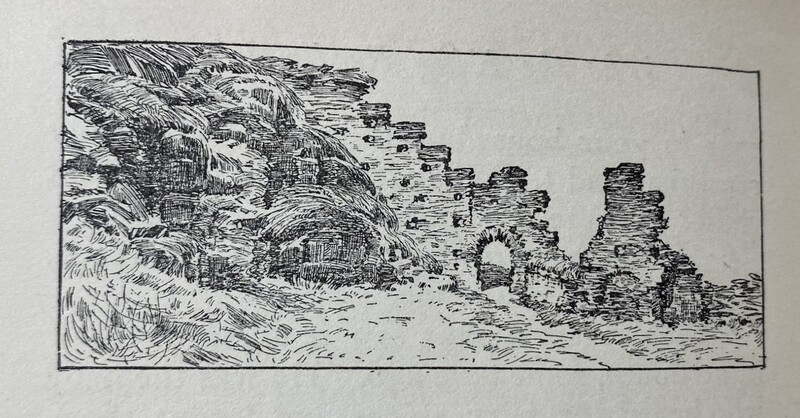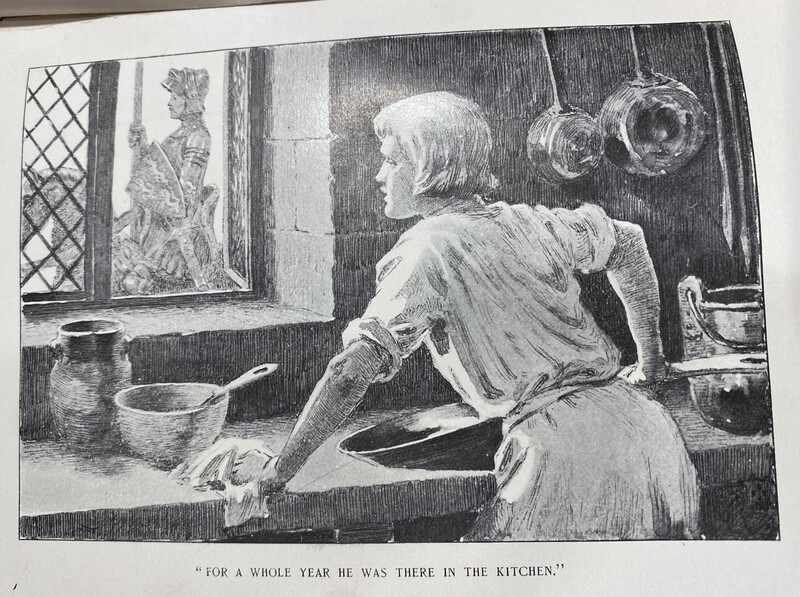Sydney Richmond Burleigh: Artist of Multiple Skills in Rhode Island
Sydney Richmond Burleigh Basics
b. July 6, 1853, Little Compton, Rhode Island
d. March 31, 1931, Providence, Rhode Island
m. Sarah Drew Wilkerson (1851-1952), June 3, 1875, Rhode Island
lived in Rhode Island
The only surviving son of George and Ruth Burgess Burleigh, Sydney Richmond Burleigh was a major regional artist in Rhode Island. He played a formative role in the histories of the Providence Art Club and the Rhode Island School of Design. During World War I he produced posters for recruitment and support of the armed forces, and was also well-known for his illustrations, paintings, and building and furniture designs. Although he was less politcally engaged than either of his parents or extended family, he clearly inherited the Burleigh artistic sensibility.
I. Early Life and Marriage to Sarah Wilkinson
Sydney Richmond Burleigh was born on either July 6 or 7 (historical records offer both dates), 1853, to George Shepard and Ruth Burgess Burleigh. He was their second and last child but the only one to survive into adulthood, as his elder sister Lillian passed as a toddler in either 1852 or 1853. The family had relocated from Plainfield, Connecticut to Ruth's hometown of Little Compton, Rhode Island sometime before Sydney's birth, and he appears to have spent most if not all of his childhood there. Much of the information that is known about Sydney's youth comes from his wife, Sarah - a twist on often knowing about women of the past only via their husbands. In a biography of Sydney that Sarah penned on the tenth anniversary of his death, she wrote that:
His boyhood days were happy, roaming the fields and shores, with the neighboring boys ad girls, and with his beloved boat. Mr Philip Wilbour, telling me of some of their exploits, said “Of course Rick was captain.” He was always called Rick in those days – His school days were passed at District no 2, on the next road near the bend of Taylor’s Lane, but his real education was with his learned parents and contact with their cultured friends.
Although letters from the extended Burleigh family suggest that some travel and visits with the rest of the family were common, Sarah unfortunately has little to say about Sydney's closeness with the rest of his family throughout his youth. However, it is known that the family was poor by Little Compton standards, and that when Sydney was 16 he left for New York City to work for a family friend. Not liking New York, he left after only three years and moved to Providence, where he worked as a draftsman for the company Brown & Sharpe, from 1873 to 1876. It was possibly here that he first began to see artistic work as a real career possibility, although certainly having a father who was a poet and artist would have helped.
A newspaper article about Sarah that was published in the Providence Journal on May 30, 1955 reveals that it was she who in fact first got Sydney interested in painting - a medium that he would come to be known for later in life. The article's summary of Sydney states that:
Sydney Burleigh was born in the mold of a hard bitted Yankee. He had passed his boyhood in Little Compton and all the schooling he ever received was at the little Number Two district schoolhouse on the Great West Road. His body was lean and scrawny; his speech laconic and twangy. With his long, nimble fingers he was ever contriving and in Providence he had become interested in art. Sarah taught him what she knew of painting and he decided to make a career of it.
Sarah, who was from a wealthy and well-established Providence family, had been a painter herself and attended art school under the tutelage of James S. Lincoln, who was later the first president of the Providence Art Club. The Journal article guesses that Sarah and Sydney likely met "in some arty gathering," but Sarah herself is silent on the circumstances of thier meeting. Regardless of how they met, however, it's clear that Sarah was a deeply influential figure in Sydney's life and the development of his career, and the two married on June 3, 1875 in Providence.
II. Artistic Career
Sydney's career as an artist began in full force in 1878, when the couple used Sarah's family wealth to travel to Europe. Here, Sydney spent two years studying with Jean Paul Laurens in Paris, before spending a winter in Italy and several other months traveling around the continent. According to Sarah he made five trips to Europe over his lifetime, "each time bringing back new ideas and richer work."
Once back in Providence, Sydney began his art career in earnest. According to Sarah, he joined the Providence Art Club, which was established not long after his return to the States in 1880, and "was one of its most devoted members for 50 years, and its beloved President for six years [1915-1921]." He served as an officer of the club from 1886 through 1931. He frequently exhibited at the club, and was affiliated with groups in other cities such as New York and Boston as well. His most famous - and most visible - artwork, the Fleur-de-Lys Studio, was designed as studio space for members of the Providence Art Club.
Given his wide range as an artist, it is difficult to pin Sydney Richmond Burleigh to only one artistic style. He is most clearly affiliated with the Arts and Crafts Movement. His paintings of landscapes make him a key regional artist for Rhode Island, whose works are still prized by locals.
Throughout his career, Sydney was also the recipient of numerous awards and acolades. According to his obituary in The Evening Bulletin, Providence, "he was awarded the bronze medal of the St. Louis Exposition in 1904, and the open prize of the Buffalo (N.Y.) Society of Artists in 1913." He was also awarded an honorary Master of Arts degree from Brown University in 1912; both his obituary and Sarah's biography of him record the notes from Dr. William H. P. Faunce upon conferral:
Sydney Richmond Burleigh, gifted with insight into nature and humanity, whose pictures adorn our homes and open our eyes. Dean of Rhode Island artists, of private virtue and public spirit.
Sydney remained a beloved and respected regional artist throughout his entire lifetime, with his obituary noting that in the two weeks prior to his death, he recovered enough from illness "that he was able to attend practically every showing of his pictures during a two weeks period at the Providence Art Club." A decade after his death, Sarah ended her biography of him by saying:
He was a welcome guest everywhere, for his genial nature and intelligence, full of kindness and wit, He was tall and handsome with an air of distinction, and always ready to help. He had a genius for making friends and keeping them. He was alive all over, with the very last never acknowledging weakness.
He died Feb. 25, 1931.
III. Providence Art Club and Fleur-de-Lys Studio
Among Sydney's most notable undertakings, and certainly his most recognizable, is the Fleur-de-Lys Studio in Providence. Located at 7 Thomas Street close to the Rhode Island School of Design campus, the building is now on the National Register of Historic Places, and is one of the most iconic structures in the city of Providence.
Sydney started designing the Fleur-de-Lys in 1885 alongside Providence architect Edmund R. Wilson, and construction continued through 1886. According to Sarah, he completed "the decoration himself, curving the oak beams and modelling in the plaster." The building was described in later newspaper accounts as "designed after the style of antiques in Chester, England: half timbered and plastered, with decorations in the colored plaster which he executed with the help of John Aldrich and Charles Walter Stetson." This timber and plaster facade is partly what makes the building so iconic, and certainly sets it apart from the more traditional houses that surround it.
Sydney intended the building to be used for artist studios, and used it himself when he and Sarah were in Providence. The Providence Art Club, which Syndey was a member of for fifty years, also used the space throughout his lifeltime. When he died in 1931, he left the building to Sarah "with the understanding that at her death it would go to the Art Club for the use of worthy young painters." However, she gave the studio to the club almost immediately after acquiring it, and it has been used by the group as art studios ever since.
The Fleur-de-Lys building was added to the National Register of Historic Places and named a National Landmark in 1992, ensuring its preservation and upkeep in the future. It was also featured in "The Call of Cthulhu," the 1926 short story by famous Rhode Islander H. P. Lovecraft. In the story, the Fleur-de-Lys is the home of artist Henry Anthony Wilcox, and is described as
A hideous Victorian imitation of seventeenth-century Breton architecture which flaunts its stuccoed front amidst the lovely colonial houses on the ancient hill, and under the very shadow of the finest Georgian steeple in America.
Although Lovecraft was clearly not a fan of the building, its iconic facade, complete with Burleigh crest, is an important part of the Providence landscape and remains Sydney's most recongizable artistic work.
IV. Little Compton and Peggotty
Although Sydney and Sarah spent much of their lives in Providence, they also owned a home in Sydney's hometown of Little Compton, and seem to have spent summers entertaining and living there. Sydney had his own studios at their Little Compton home, including most famously, a boat named "Peggotty."
The Providence Journal article about Sarah states that the couple's Little Compton home was built by George, and was assumedly a family house that passed to Sydney at some point. The piece describes it as "the little brown cottage, embraced by the wisteria," which matches images held by the Little Compton Historical Society of the Burleigh home. His obituary adds that this home was called "Owl's Nest," and that Sydney had fashioned both the homes and gardens "in the Japanese manner." Sarah added in her biography that in 1881 they installed a tennis court on the grounds of the house, "and it was the centre of general outdoor amusement for all around in Compton, every body welcome, during fifteen years, before the Golf Club was formed."
From all accounts, it seems that Owl's Nest was a social space for artists and Little Compton residents, where Sarah and Sydney as well as George and Ruth spent much of their time surrounded by friends and loved ones. However, the house itself was not the focal point of Sydney's work in Little Compton.
Besides the Fleur-de-Lys studio, Sydney's other infamous architectural feat was "Peggotty," a catboat turned studio that he installed on the grounds of Owl's Nest around 1906. According to Benjamin F. Wilbour, the boat "had historical value for it was the very small ferry boat run by Deacon Church from Taylor's Lane to Middletown. It was used by farmers to get their produce, butter and eggs etc., to Newport which was the principle market around here, for at that time Fall River was nothing but an overgrown village." Sydney apparently discovered the boat abandoned and took it back to his house, adding a thatched roof and supports that allowed it to sit on land. The boat's name came from the Peggotty family in Charles Dickens' work David Copperfield, who famously lived in a house that was a converted boat.
Peggotty is often mentioned in accounts of Sydney's life because of its uniqueness as a structure. Artists and students also worked with Sydney in this studio, and since 1962 it has been owned and maintained by the Little Compton Historical Society. It is used today as a museum building and is accessible to visitors. The LCHS has a wonderful webpage about this unique piece of the Burleigh story, which can be accessed here.
This page will grow exponentially in the coming years, because Sydney Burleigh's life is well-documented, and our partners at the Little Compton Historical Society have many files on his work, including this lovely study of his cottage studio "Peggoty" (named after the Peggoty family in Dickins' David Copperfield, who famously lived in a house like this that was a converted boat) in Little Compton.
In the meantime, enjoy this small gallery of Sydney Richmond Burleigh's graphic art work and painting.
References
- Burleigh, Sarah. "Sydney Richmond Burleigh." Feburary 25, 1941. A47.3. Little Compton Historical Society, Little Compton, RI.
- Emlen, Robert P., "Picturing the Worthies: An Introduction to the Brown Portrait Collection," https://library.brown.edu/cds/portraits/intro.html . Office of the University Curator, Brown University, 2003.
- Lisle, Janet. The Life and Works of Sydney Burleigh 1853-1931. Little Compton RI: Little Compton Historical Society. Biographical pamphlet accompanying Wilbor House Museum exhibit of July 2 - September 4, 2006.
- Lovecraft, H. P. "The Call of Cthulhu." Weird Tales. Feburary 1928.
- Patten, David. "Our Rhode Island: 'Dear Lady of College Hill.'" The Providence Journal. May 30, 1955. Little Compton Historical Society, Little Compton, RI.
- Unknown. "Death Summons Sydney Burleigh." The Evening Bulletin, Providence. February 26, 1931. Little Compton Historical Society, Little Compton, RI.
- Wilbour, Benjamin F. "Sydney Richmond Burleigh." A47.3. Little Compton Historical Society, Little Compton, RI.
